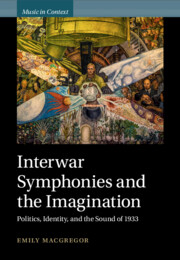Book contents
- Interwar Symphonies and the Imagination
- Music in Context
- Interwar Symphonies and the Imagination
- Copyright page
- Dedication
- Contents
- Figures
- Examples
- Preface
- Acknowledgements
- Abbreviations
- 1 Between Europe and America: Kurt Weill’s Symphony in a Suitcase
- 2 Listening for the Intimsphäre in Hans Pfitzner’s Symphony in C♯ Minor
- 3 Liberalism, Race, and the American West in Roy Harris’s Symphony 1933
- 4 Aaron Copland’s and Carlos Chávez’s Pan-American Bounding Line
- 5 Arthur Honegger’s ‘Modernised Eroica’
- 6 The Right Kind of Symphonist: Florence Price and Kurt Weill
- Select Bibliography
- Index
5 - Arthur Honegger’s ‘Modernised Eroica’
Paris – Berlin
Published online by Cambridge University Press: 28 January 2023
- Interwar Symphonies and the Imagination
- Music in Context
- Interwar Symphonies and the Imagination
- Copyright page
- Dedication
- Contents
- Figures
- Examples
- Preface
- Acknowledgements
- Abbreviations
- 1 Between Europe and America: Kurt Weill’s Symphony in a Suitcase
- 2 Listening for the Intimsphäre in Hans Pfitzner’s Symphony in C♯ Minor
- 3 Liberalism, Race, and the American West in Roy Harris’s Symphony 1933
- 4 Aaron Copland’s and Carlos Chávez’s Pan-American Bounding Line
- 5 Arthur Honegger’s ‘Modernised Eroica’
- 6 The Right Kind of Symphonist: Florence Price and Kurt Weill
- Select Bibliography
- Index
Summary
Premiered in Berlin, but composed in Paris, Arthur Honegger’s Mouvement symphonique n° 3 was a commission for the Berlin Philharmonic, and Chapter 5 deals with its reception, bringing the book back to its two major European centres. For reviewers, Swiss-German Honegger’s work, the third in a trio of symphonic movements that began with Pacific 231 and Rugby, was unambiguously neither French nor German, and it reveals mechanisms by which commentators sought either to assimilate the work with, or expel it from, Germanic idealist aesthetic traditions. Despite the work’s ‘sober and unprepossessing’ title, this chapter suggests that Mouvement symphonique n° 3 had a critical political programme – even if programmatic aspects were barely acknowledged in the critical reception. Manipulating the symphonic form, and referencing Beethovenian subjective narratives in particular, the work considers the changing relationship between the individual and the collective within a tumultuous era of political and industrial/technological upheaval, ultimately lamenting over the ruins of both the symphony and the utopian political project it represented.
- Type
- Chapter
- Information
- Interwar Symphonies and the ImaginationPolitics, Identity, and the Sound of 1933, pp. 169 - 205Publisher: Cambridge University PressPrint publication year: 2023

